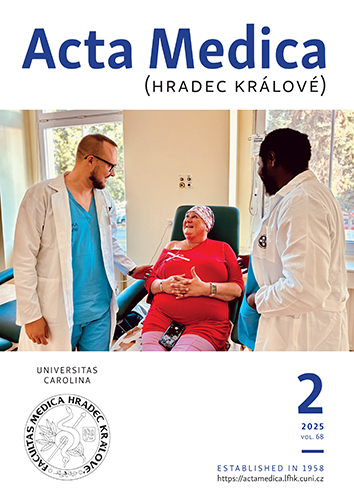ACTA MEDICA, Vol 67 No 4 (2024), 113–124
Updated Meta-Analysis of VDR FokI and TaqI Variants and Their Association with Melanoma Risk
Nazila Farnoush, Mehdi Khosravi-Mashizi, Amirhossein Rahmani, Maedeh Barahman, Sepideh Soleymani, Fatemeh Asadian, Ahmad Shirinzadeh-Dastgiri, Mohammad Vakili-Ojarood, Seyed Masoud HaghighiKian, Amirhosein Naseri, Maryam Aghasipour, Amirmasoud Shiri, Kazem Aghili, Hossein Neamatzadeh
DOI: https://doi.org/10.14712/18059694.2025.8
zveřejněno: 04. 04. 2025
Abstract
Background: Research suggests that melanoma patients with low vitamin D levels exhibit a higher risk of tumor ulceration and increased tumor mitotic rates. This has led to investigations into the vitamin D receptor (VDR) gene concerning its potential link to melanoma susceptibility. This meta-analysis aims to explore the association between VDR FokI and TaqI polymorphisms and melanoma risk, with an emphasis on the need for research in diverse populations to enhance our conclusions regarding interactions between skin phenotypes and VDR variations. Methods: A comprehensive literature search was conducted in databases, including PubMed, Scopus, and Web of Science, for studies linking VDR polymorphisms to melanoma risk, up to February 1, 2024. Keywords used included “Melanoma”, “VDR”, and various genetic terms. Quantitative synthesis was performed with Comprehensive Meta-Analysis (Version 4.0) and a significance threshold set at p < 0.05. Results: A total of twenty-one case-control studies involving 8,813 melanoma cases and 7,973 controls were included. Twelve studies on FokI had 4,642 cases and 4,534 controls, while nine TaqI studies included 4,171 cases and 3,439 controls. The results show a significant association between the VDR FokI polymorphism and increased melanoma risk across four genetic models (allele model: OR = 1.128, 95% CI 1.026–1.241; P = 0.013; homozygote model: OR = 1.166, 95% CI 1.020–1.332; P = 0.025; heterozygote model: OR = 1.255, 95% CI 1.046–1.507; P = 0.015; dominant model: OR = 1.243, 95% CI 1.052–1.470; P = 0.011). In contrast, the TaqI polymorphism showed no significant association with melanoma risk in the general population. Conclusions: This meta-analysis suggests that the VDR FokI polymorphism is linked to an increased susceptibility to melanoma, while the TaqI variant does not show a significant association. Future research should explore the interactions between VDR polymorphisms, skin phenotypes, and melanoma risk in diverse populations, with larger and more varied studies needed to confirm these findings and enhance our understanding of genetic factors affecting melanoma susceptibility.
klíčová slova: melanoma; vitamin D; VDR; polymorphism; genetic susceptibility; meta-analysis

Updated Meta-Analysis of VDR FokI and TaqI Variants and Their Association with Melanoma Risk is licensed under a Creative Commons Attribution 4.0 International License.
210 x 297 mm
vychází: 4 x ročně
cena tištěného čísla: 150 Kč
ISSN: 1211-4286
E-ISSN: 1805-9694
